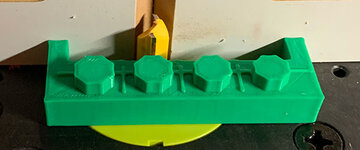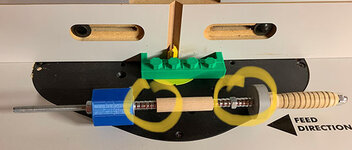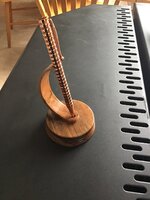Wmcullen
Member
I'm not sure if this process is right or wrong; unique or common. But it works for me and I want to share in case it's interesting. |
24: Consistent Facet Width Jig
last post: 23- Pen Shaping: Wood/Nib Connection


I put together a simple measuring jig to ensure consistent distances between my router table and pen blanks while making faceted pens.
The Problemlast post: 23- Pen Shaping: Wood/Nib Connection
I put together a simple measuring jig to ensure consistent distances between my router table and pen blanks while making faceted pens.
I was shocked at how small differences in the distance between my pen blank and the router bit had BIG consequences. Two setups I thought were similar yielded one pen that felt too thin while another felt too fat.
Solution
(Not rocket surgery, just how I did it.)
I constructed a jig to help me set up the router fence consistently.
Process
1. I turned two hard maple blanks to about 0.5"
2. Each blank was transferred onto an octagonal cutting guide and I used my new measuring jig to set up the router table.
More info about the octagonal cutting guide found here and at the end of the post.
The jig mimics the width of the pen that will be cut. The changes are subtle but affect the "feel" of the pen immensely.
3. Once both pieces are cut, they are returned to the lathe for cleanup.
Summary
I'm usually not overly concerned with consistency: I like that no two pens I make are the same.
But I felt too little control over the wild differences in my pen widths and needed to address it.
This system gives me back the control I'm looking for. It's not "hyper-exact" but brings things back within a tolerance I find comfortable.
3D Models
A usable version of the octagonal jig can be found here.
I'm also attaching a simplified version as well as the measuring jig inside an attached zip file. called OctagonJig.zip.



